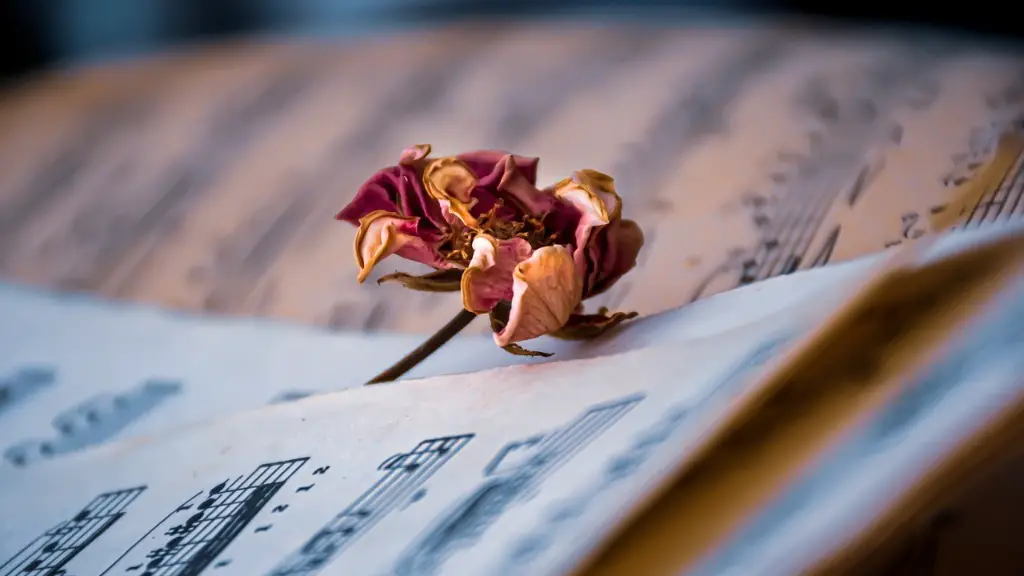What is the Definition of Theme in Poetry?
Theme in poetry is a central idea or message that unifies the poem. It is usually expressed through several images, symbols, and references that relate to a common concept that is addressed within the poem. It is a universal truth that can be applied to any culture or situation and can be used to compare or contrast different people or objects. An example of a theme used in a poem might be “love conquers all” or “life is a journey”. Thematic elements in a poem are made up of words and ideas that are deliberately used to convey an idea or point. The use of imagery, symbols, and metaphors can both explain and emphasize the theme, allowing readers to understand the poem on a deeper level.
The central theme is often the primary message or insight that a poet wants to share with the reader. This concept might be revealed in the title, setting, plot, characters, lines, or images. The theme in a poem should be clear and direct. Poetry can be used to provide insight into a topic, evoke emotion, or simply express an idea. In today’s world, themes in poems tend to reflect feelings of love, loss, and struggle. The central theme of a poem should be revealed in all parts of the poem so that readers can identify and understand it.
Thematic elements are used to enhance and enrich a poem. Allusions, historical references, and word choice can create a rich and vivid backdrop for the poem, allowing readers to connect to the central theme. Themes can also be expressed through structures such as rhyme, meter, and stanzas. Rhyme, meter, and allusions are often used to emphasize certain words or phrases in the poem, bringing attention to the main theme or concept. By understanding how to identify and how to use themes in a poem, authors can create powerful and meaningful works of art.
Figurative Language
Figurative language is an important tool for expressing the theme of a poem. Commonly used figures of speech include figurative comparisons such as similes and metaphors. These figures of speech can be used to make connections between unrelated things, emphasizing the theme of the poem and the meaning behind it. For example, a poem that discusses the power of love might use a metaphor to compare it to a raging river. This allows the reader to understand how powerful love can be in a way that would not be possible if the author simply said “love is powerful”.
Figurative language can also be used to evoke emotion in the reader, making them feel the same way that the author is trying to convey. Authors can use metaphors and similes to emphasize ideas that would seem mundane if expressed in literal terms. For example, a poem about a sunset might use metaphors to compare the sky to a painting, or the clouds to mountains. This allows readers to relate to the poem on a personal level and hopefully understand and appreciate the author’s message.
Types of Theme in Poetry
There are many different types of theme in poetry. Authors might use the same theme multiple times in different works, or focus on entirely different themes in each poem. Some common themes in poetry include love, nature, death, loss, pain, hope, new life, and nostalgia. Themes can range from abstract concepts to specific topics. For instance, a poem may be about the hope of finding a job after a period of unemployment, while another poem may focus on the abstract concept of perseverance in the face of hardship.
Themes in poems can be used to contrast different characters or objects. Some themes are used to express joy and hope, while others may be used to explore grief and pain. There are also themes that focus on identity and relationships. No matter what type of theme the poem uses, its central idea should be clear and well-articulated in order for readers to relate to it.
Identifying Theme in Poetry
Identifying the theme of a poem can be a difficult task for some readers. A good place to start is by looking for figurative language, symbols, and allusions. These can provide helpful clues about the poem’s main purpose and message. Once these elements have been identified, it is then possible to look for patterns in the text. This could include repeating words or images, or comparisons between different subjects or objects.
The title of the poem can also be a helpful indicator of a poem’s theme. Common titles for poems discussing love might include “A Love Letter” or “The Greatest Love”. This tells readers that the poem is likely to discuss themes related to love, either in a literal or abstract sense. Once the initial theme has been identified, readers can look further into the poem to gain a better understanding of the author’s message.
Role of Theme in Poetry
The theme of a poem is the core message that the author is trying to convey. This is the idea that readers should take away from the poem, and it should be a universal truth that applies to all cultures and situations. Authors use a combination of imagery, symbols, and figures of speech to emphasize the theme. This allows them to create a rich and vivid backdrop for their poem, as well as helping readers to connect to the main idea on a deeper level. By understanding how to identify and use themes, authors can create powerful and meaningful works of art.
Universal Appeal of Themes in Poetry
Themes in poetry have universal appeal. Whether it’s a poem about love, loss, or hope, readers of all ages and backgrounds can relate to the author’s message. This is why many of these themes have been used for hundreds, if not thousands of years. The power of poetry comes from the fact that authors can express complex ideas and emotions in just a few words. By understanding the elements of a poem and what the author is trying to convey, readers can connect to the poem in a personal way.
Themes in poetry can evoke deep emotions in readers, making them think and reflect on their own lives and experiences. A powerful poem can make readers feel connected to the author and the work, allowing them to understand the poem in a way that they may not have before. Through thoughtful and careful use of language, authors can create works of art that will resonate with readers long after the poem has been read.
Understanding Theme in A Poem
Understanding theme in a poem takes practice. It is important to look for elements such as imagery, symbols, and figurative language that the author has used to enhance and enrich the poem. Paying attention to the title, plot, and characters can also give readers an idea of the main idea that the author is trying to convey. Themes can range from abstract concepts to specific topics, and by taking the time to better understand the poem, readers can gain insight into the author’s message.
Themes in poetry can evoke strong emotions and create powerful connections between the author and the reader. By understanding how to identify and use themes, authors can create meaningful works of art that will have a lasting impact on readers. Understanding theme in poetry is an important part of appreciating and reflecting on the poem, which can ultimately lead to a deeper understanding of the author’s message.



